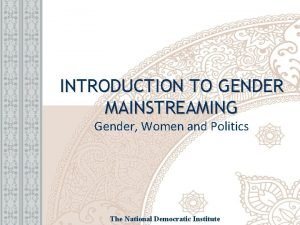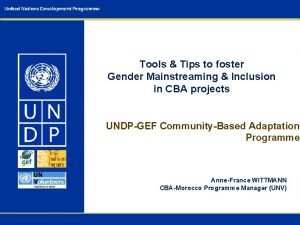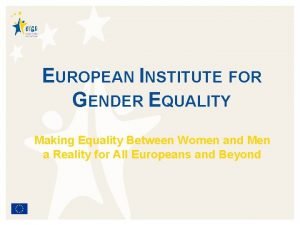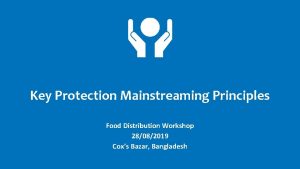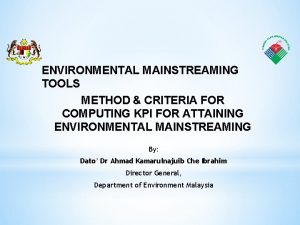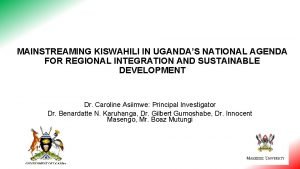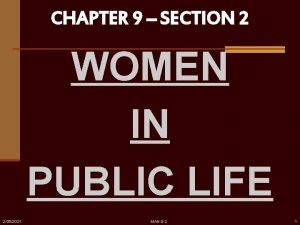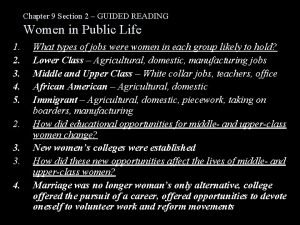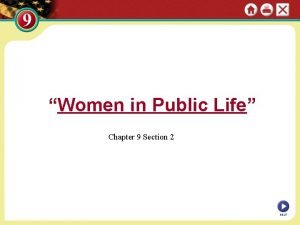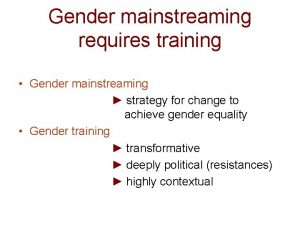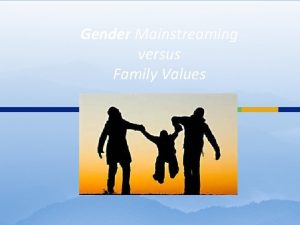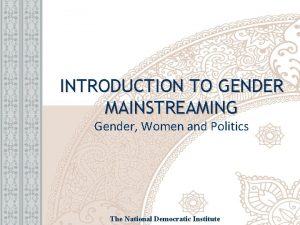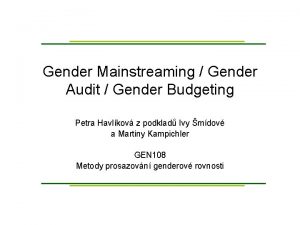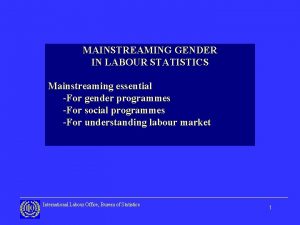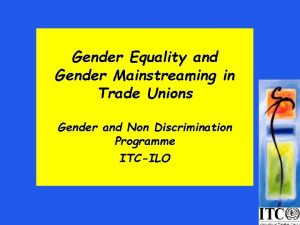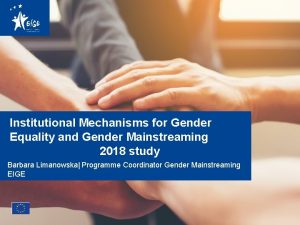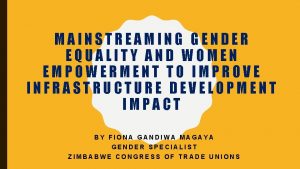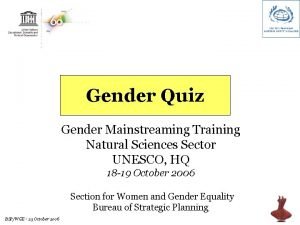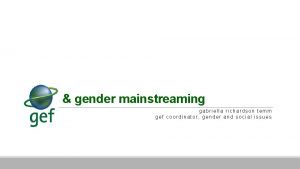UNESCOs Gender Mainstreaming policy Section for Women and



















- Slides: 19

UNESCO’s Gender Mainstreaming policy Section for Women and Gender Equality Bureau of Strategic Planning

UNESCO’s Medium-Term Strategy 2002 -2007 (31 C/4) UNESCO contributing to peace and human development in an era of globalization through education, the sciences, culture and communication Two Cross-Cutting Themes Eradication of poverty, especially extreme poverty The contribution of information and communication technologies to the development of education, science, culture and the construction of a knowledge society Three Main Strategic Thrusts Developing and promoting universal principles and norms, based on shared values, in order to meet emerging challenges in education, science, culture and communication and to protect and strengthen the "common public good". Promoting pluralism, through recognition and safeguarding of diversity together with the observance of human rights. Promoting empowerment and participation in the emerging knowledge society through equitable access, capacity-building and sharing of knowledge …and 12 Strategic Objectives and international development targets to be met

31 C/4 Medium Term Strategy, para. 32 states that: “UNESCO’s programme activities will be targeted at the urgent needs of disadvantaged and excluded groups or geograpchic regions. The needs of Africa, the least developed countries, WOMEN and youth will be mainstreamed throughout all programmes ”

How can this be done ?

Gender equality cannot come about only through changes in women’s condition. A profound transformation of the structures and systems, which lie at the root of women’s subordination and gender inequality, is required. We must address both women’s Practical Strategic & needs interests To do this, we must mainstream gender concerns in our operations.

UNESCO’s Gender Mainstreaming Implementation Framework - GMIF üDefines what is mainstreaming üExplains what it means to ‘gender mainstream’ at an institutional and programme level üEstablishes UNESCO’s basic principles for ‘gender mainstreaming’ üDefines lines of responsibility and mechanisms for monitoring üCommits Organization to capacity building

GM is a process. The ultimate goal is for women and men alike to enjoy human security throughout the world. To build societies where women and men, freed from want and fear, can reach their full human potential and participate, as equals, in the development of their societies, sharing its wealth and benefits on the basis of parity.

This process is about making sure that Gender concerns are fully (and routinely) taken into account in all of UNESCO’s actions and programmes and during all phases of programme development, implementation and evaluation

UNESCO’s guiding principles for mainstreaming gender : u Policy of recognition u Diversity and intersection u Equality u Equity u Empowerment and agency u Participation and parity u Partnership with men u Social justice

Basic measures to mainstream gender: • 1 Include GENDER NEEDS and GENDER CONTEXT ANALYSES as an integral part for assessment of global, regional and national challenges • 2 Establish attainable GENDER OBJECTIVES, results, and performance indicators, in line with International development targets • 3 Align RESOURCES (human + $) with objectives • 4 Ensure EQUAL REPRESENTATION and PARTICIPATION of women and men in UNESCO-sponsored activities and programmes • 5 Measure and monitor attainment of GENDER OBJECTIVES through GENDER IMPACT studies and evaluations and GENDERSENSITIVE indicators.

Measuring performance Indicators are used to measure + monitor the achievement of expected results and establish the “success” of our work. Good indicators are: n Realistic: we have the means to verify (availability of data, feasible in time, etc) + attainable n Meaningful: the link between the indicator and objective sought is clear and can be demonstrated n Quantitative n Qualitative n Time-bound n include Input, Process and Outcome indicators n (are determined by/with populations concerned)

Gender-sensitive indicators n address the gaps and inequalities you are seeking to redress nrequires the collection of data, disaggregated by sex, as well as by age and socio-economic and ethnic groups na long-term perspective is taken (i. e. , social change takes time); and nparticipatory approaches are used, where women and men actively take part in the planning of performance measurement frameworks, in their implementation, and in the discussion of their findings.

We must MOBILIZE and SHARE our knowledge capital for the formulation of evidence-based policies and the development of innovative programme approaches. Experience Evidence based policies Critical assessment/ Lessons learned

Institutional arrangements in place to support UNESCO’s Gender Mainstreaming process…

- Current arrangments Network of Gender Focal Points (FO+HQ+NATCOM) * Women and Gender Equality section in BSP *SHS has a Women, Gender and Development Unit

- Lines of responsibility- Sector ADGs, and Field Office Directors must provide leadership in implementing the Organization’s mainstreaming policy, develop sector- and regional specific strategies and policies as appropriate, monitor overall implementation and facilitate the effective operation of gender focal points. - The College of ADGs shall, in the context of its overall monitoring exercise of programme implementation, ensure that indeed sufficient attention is being paid in programme activities to gender objectives.

Role of the Women and Gender Equality Section • Forge, within UNESCO, its Member States and at a regional and global level, political commitment to gender equality, women’s empowerment and women’s and girls’ human rights; • Reinforce and stimulate gender mainstreaming in UNESCO’s programmes • Support capacity-building in Member States, particularly by developing holistic and multi-disciplinary approaches to gender issues; and by encouraging closer collaboration between National Commissions for UNESCO and ‘national machineries for Beijing follow-up’; • Increase co-operation with other United Nations entities, international and regional intergovernmental organizations, major international NGOs, private foundations and private sector partners and raise UNESCO’s profile and visibility in this context.

Role of Gender Focal Points (HQ +FO) Have the responsibility to monitor at project level the application of the mainstreaming principles and to stimulate the wider inclusion of gender concerns and intensified responses to women’s needs in a Sector programme.

Each Programme Sector is RESPONSIBLE for pursuing GENDER OBJECTIVES
 What is gender mainstreaming?
What is gender mainstreaming? What is gender mainstreaming?
What is gender mainstreaming? Gender mainstreaming
Gender mainstreaming Gender mainstreaming
Gender mainstreaming Strategic gender needs and practical gender needs
Strategic gender needs and practical gender needs Protection mainstreaming principles
Protection mainstreaming principles Environmental mainstreaming tools
Environmental mainstreaming tools Mainstreaming in swahili
Mainstreaming in swahili Paradigm shift from women studies to gender studies
Paradigm shift from women studies to gender studies Ifrc gender and diversity policy
Ifrc gender and diversity policy Chapter 9 section 2 women in public life
Chapter 9 section 2 women in public life Chapter 9 section 2 women's in public life answer key
Chapter 9 section 2 women's in public life answer key Chapter 9 section 2 women in public life
Chapter 9 section 2 women in public life Fspos
Fspos Typiska novell drag
Typiska novell drag Nationell inriktning för artificiell intelligens
Nationell inriktning för artificiell intelligens Returpilarna
Returpilarna Varför kallas perioden 1918-1939 för mellankrigstiden?
Varför kallas perioden 1918-1939 för mellankrigstiden? En lathund för arbete med kontinuitetshantering
En lathund för arbete med kontinuitetshantering Kassaregister ideell förening
Kassaregister ideell förening
